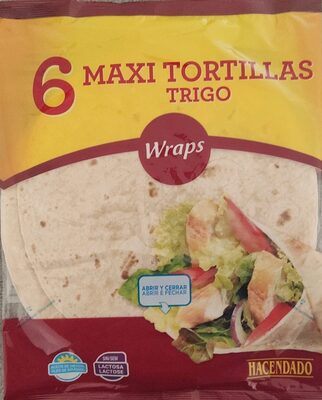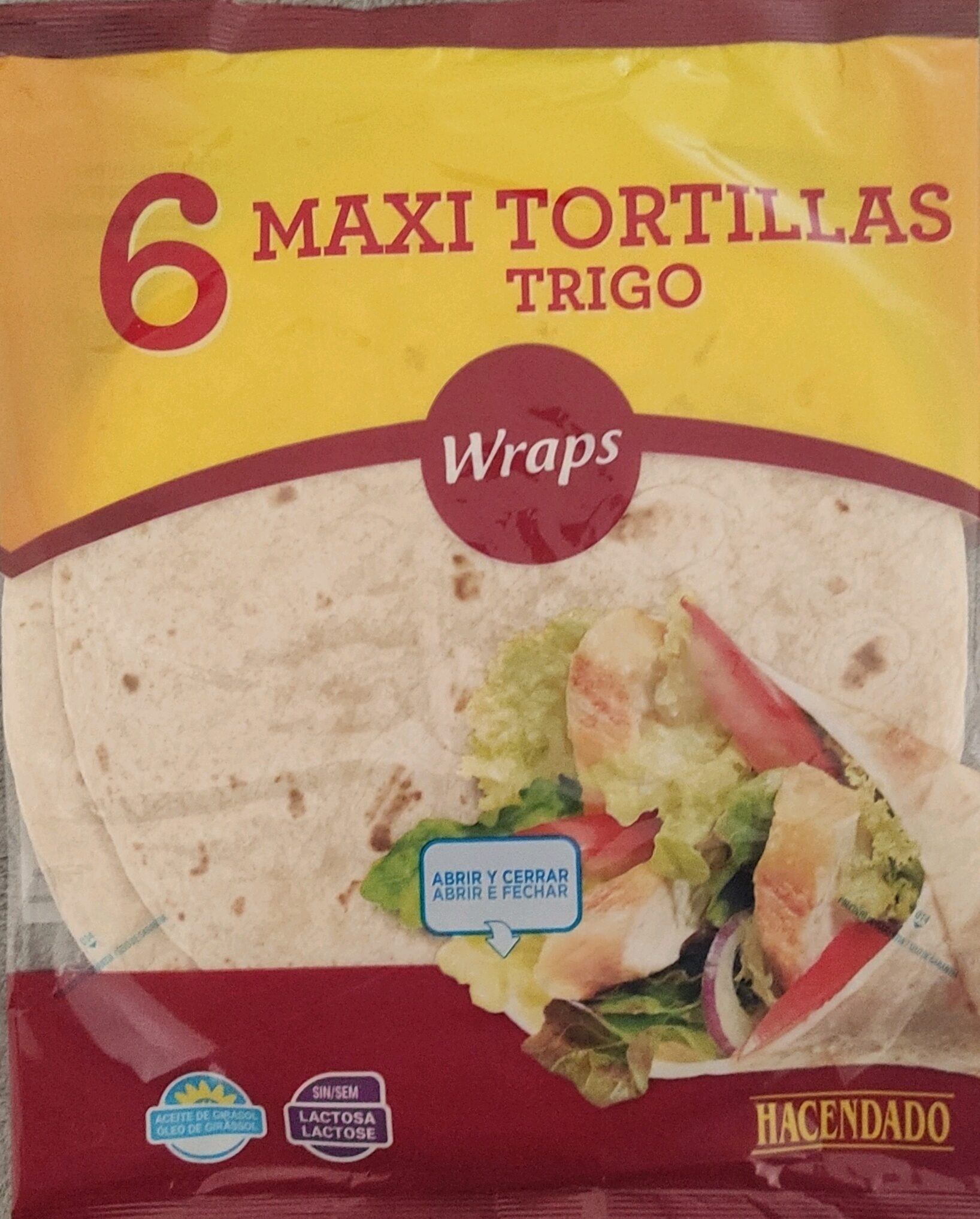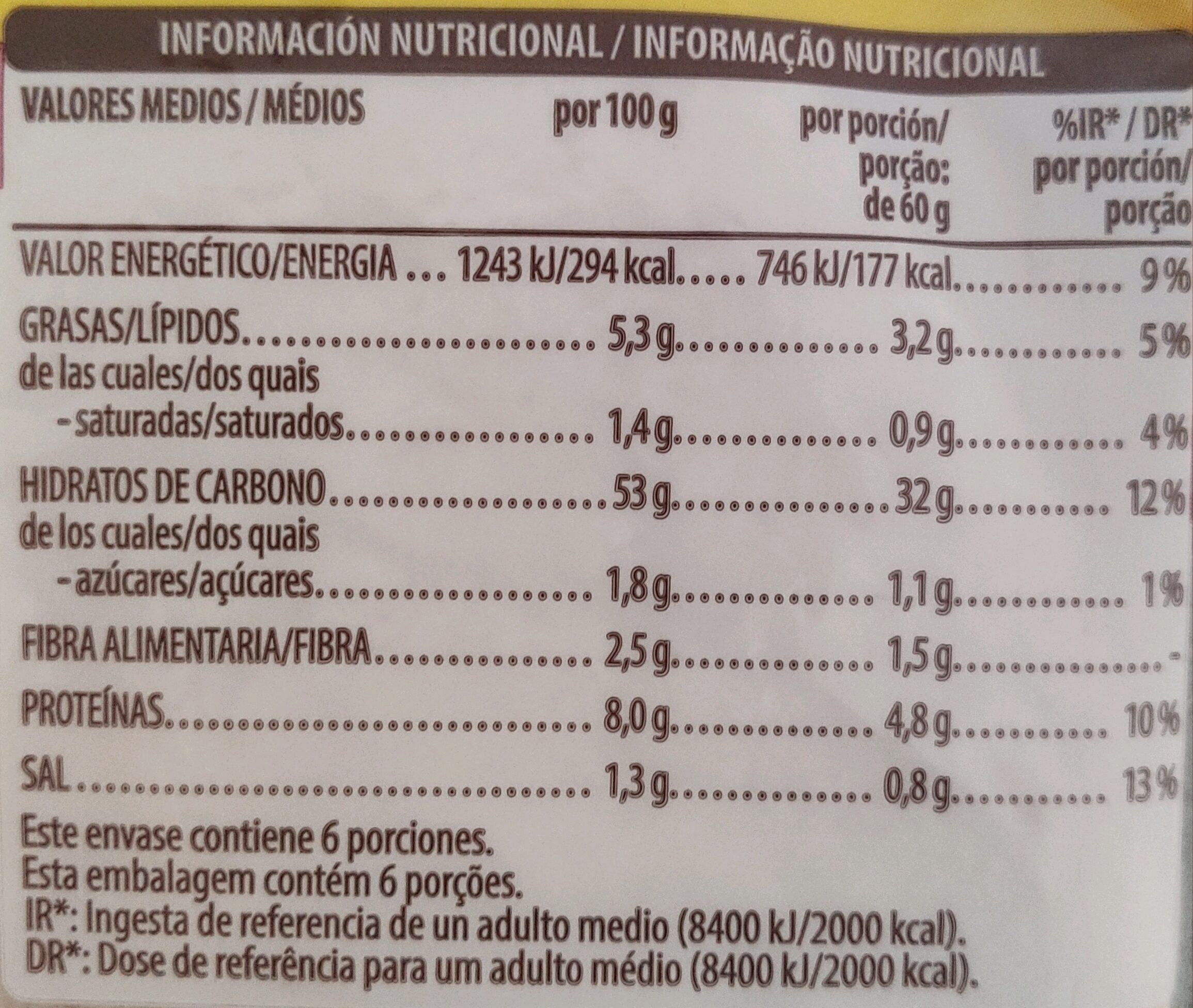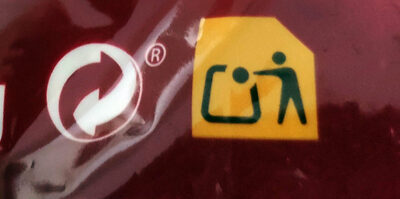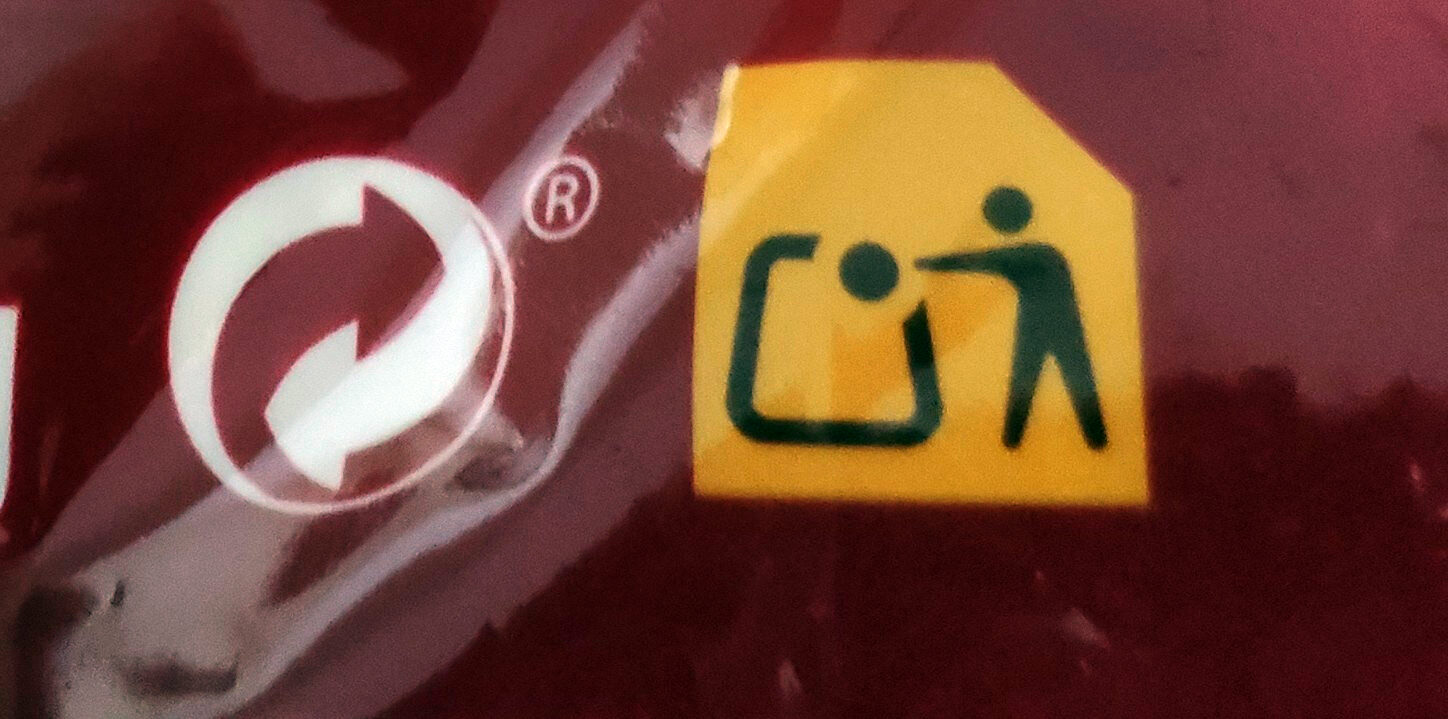Ajuda'ns a fer que la transparència alimentària sigui la norma!
Com a organització sense ànim de lucre, depenem de les vostres donacions per continuar informant els consumidors de tot el món sobre tot allò què mengen.
La revolució alimentària comença amb tu!
Maxi tortillas trigo wraps - Hacendado - 360 g (6 x 60 g)
Maxi tortillas trigo wraps - Hacendado - 360 g (6 x 60 g)
Codi de barres: 8480000808707 (EAN / EAN-13)
Nom comú: Tortillas de trigo
Quantitat: 360 g (6 x 60 g)
Empaquetament: Plàstic, es:Green dot
Marques: Hacendado
Categories: Aliments i begudes amb base vegetal, Aliments amb base vegetal, Cereals i patates, Cereals i derivats, Creps i coques, Pans, en:Flatbreads, Pastissos de cereals inflats, en:Puffed wheat cakes, en:White breads, en:Pancakes, en:Wheat breads, en:Wheat flatbreads
Etiquetes, certificacions, premis:
Punt verd, Sense lactosa, Amb oli de gira-sol, es:Recicla-amarillo

Origen del producte i / o dels seus ingredients: España
Origen dels ingredients: Espanya
Llocs de fabricació o processament: Spain
Codi de traçabilitat: ES 20.43427/V CE
Botigues: Mercadona
Matching with your preferences
Salut
Ingredients
-
19 ingredients
Castellà: Harina de trigo 69 %, agua, aceite de girasol alto oleico 3 %, estabilizante (E422), emulgente (E471), sal, corrector de acidez (E296), conservadores (E202, E282), gasificante (E500ii), espesante (E415), agente de tratamiento de la harina (E920).Al·lèrgens: en:Gluten
Processament d'aliments
-
Aliments ultra processats
Elements que indiquen que el producte està al grup 4 - Aliments i begudes ultraprocessats:
- Additiu: E415 - Goma de xantè
- Additiu: E422 - Glicerol
- Additiu: E471 - Monoglicèrids i diglicèrids d'àcids grassos
- Ingredient: Emulsionant
- Ingredient: Espessidor
Els productes alimentaris es classifiquen en 4 grups segons el seu grau de processament:
- Aliments no processats o mínimament processats
- Ingredients culinaris processats
- Aliments processats
- Aliments ultra processats
La determinació del grup es fa en funció de la categoria del producte i dels ingredients que conté.
Additius
-
E202 - Sorbat de potassi
Potassium sorbate: Potassium sorbate is the potassium salt of sorbic acid, chemical formula CH3CH=CH−CH=CH−CO2K. It is a white salt that is very soluble in water -58.2% at 20 °C-. It is primarily used as a food preservative -E number 202-. Potassium sorbate is effective in a variety of applications including food, wine, and personal-care products. While sorbic acid is naturally occurring in some berries, virtually all of the world's production of sorbic acid, from which potassium sorbate is derived, is manufactured synthetically.Origen: Wikipedia (Anglès)
-
E282 - Propanoat de calci
Calcium propanoate: Calcium propanoate or calcium propionate has the formula Ca-C2H5COO-2. It is the calcium salt of propanoic acid.Origen: Wikipedia (Anglès)
-
E296 - Àcid màlic
Malic acid: Malic acid is an organic compound with the molecular formula C4H6O5. It is a dicarboxylic acid that is made by all living organisms, contributes to the pleasantly sour taste of fruits, and is used as a food additive. Malic acid has two stereoisomeric forms -L- and D-enantiomers-, though only the L-isomer exists naturally. The salts and esters of malic acid are known as malates. The malate anion is an intermediate in the citric acid cycle.Origen: Wikipedia (Anglès)
-
E415 - Goma de xantè
Xanthan gum: Xanthan gum -- is a polysaccharide with many industrial uses, including as a common food additive. It is an effective thickening agent and stabilizer to prevent ingredients from separating. It can be produced from simple sugars using a fermentation process, and derives its name from the species of bacteria used, Xanthomonas campestris.Origen: Wikipedia (Anglès)
-
E422 - Glicerol
Glycerol: Glycerol -; also called glycerine or glycerin; see spelling differences- is a simple polyol compound. It is a colorless, odorless, viscous liquid that is sweet-tasting and non-toxic. The glycerol backbone is found in all lipids known as triglycerides. It is widely used in the food industry as a sweetener and humectant and in pharmaceutical formulations. Glycerol has three hydroxyl groups that are responsible for its solubility in water and its hygroscopic nature.Origen: Wikipedia (Anglès)
-
E471 - Monoglicèrids i diglicèrids d'àcids grassos
Mono- and diglycerides of fatty acids: Mono- and diglycerides of fatty acids -E471- refers to a food additive composed of diglycerides and monoglycerides which is used as an emulsifier. This mixture is also sometimes referred to as partial glycerides.Origen: Wikipedia (Anglès)
-
E500 - Carbonats de sodi
Sodium carbonate: Sodium carbonate, Na2CO3, -also known as washing soda, soda ash and soda crystals, and in the monohydrate form as crystal carbonate- is the water-soluble sodium salt of carbonic acid. It most commonly occurs as a crystalline decahydrate, which readily effloresces to form a white powder, the monohydrate. Pure sodium carbonate is a white, odorless powder that is hygroscopic -absorbs moisture from the air-. It has a strongly alkaline taste, and forms a moderately basic solution in water. Sodium carbonate is well known domestically for its everyday use as a water softener. Historically it was extracted from the ashes of plants growing in sodium-rich soils, such as vegetation from the Middle East, kelp from Scotland and seaweed from Spain. Because the ashes of these sodium-rich plants were noticeably different from ashes of timber -used to create potash-, they became known as "soda ash". It is synthetically produced in large quantities from salt -sodium chloride- and limestone by a method known as the Solvay process. The manufacture of glass is one of the most important uses of sodium carbonate. Sodium carbonate acts as a flux for silica, lowering the melting point of the mixture to something achievable without special materials. This "soda glass" is mildly water-soluble, so some calcium carbonate is added to the melt mixture to make the glass produced insoluble. This type of glass is known as soda lime glass: "soda" for the sodium carbonate and "lime" for the calcium carbonate. Soda lime glass has been the most common form of glass for centuries. Sodium carbonate is also used as a relatively strong base in various settings. For example, it is used as a pH regulator to maintain stable alkaline conditions necessary for the action of the majority of photographic film developing agents. It acts as an alkali because when dissolved in water, it dissociates into the weak acid: carbonic acid and the strong alkali: sodium hydroxide. This gives sodium carbonate in solution the ability to attack metals such as aluminium with the release of hydrogen gas.It is a common additive in swimming pools used to raise the pH which can be lowered by chlorine tablets and other additives which contain acids. In cooking, it is sometimes used in place of sodium hydroxide for lyeing, especially with German pretzels and lye rolls. These dishes are treated with a solution of an alkaline substance to change the pH of the surface of the food and improve browning. In taxidermy, sodium carbonate added to boiling water will remove flesh from the bones of animal carcasses for trophy mounting or educational display. In chemistry, it is often used as an electrolyte. Electrolytes are usually salt-based, and sodium carbonate acts as a very good conductor in the process of electrolysis. In addition, unlike chloride ions, which form chlorine gas, carbonate ions are not corrosive to the anodes. It is also used as a primary standard for acid-base titrations because it is solid and air-stable, making it easy to weigh accurately.Origen: Wikipedia (Anglès)
-
E500ii - Bicarbonat de sodi
Sodium carbonate: Sodium carbonate, Na2CO3, -also known as washing soda, soda ash and soda crystals, and in the monohydrate form as crystal carbonate- is the water-soluble sodium salt of carbonic acid. It most commonly occurs as a crystalline decahydrate, which readily effloresces to form a white powder, the monohydrate. Pure sodium carbonate is a white, odorless powder that is hygroscopic -absorbs moisture from the air-. It has a strongly alkaline taste, and forms a moderately basic solution in water. Sodium carbonate is well known domestically for its everyday use as a water softener. Historically it was extracted from the ashes of plants growing in sodium-rich soils, such as vegetation from the Middle East, kelp from Scotland and seaweed from Spain. Because the ashes of these sodium-rich plants were noticeably different from ashes of timber -used to create potash-, they became known as "soda ash". It is synthetically produced in large quantities from salt -sodium chloride- and limestone by a method known as the Solvay process. The manufacture of glass is one of the most important uses of sodium carbonate. Sodium carbonate acts as a flux for silica, lowering the melting point of the mixture to something achievable without special materials. This "soda glass" is mildly water-soluble, so some calcium carbonate is added to the melt mixture to make the glass produced insoluble. This type of glass is known as soda lime glass: "soda" for the sodium carbonate and "lime" for the calcium carbonate. Soda lime glass has been the most common form of glass for centuries. Sodium carbonate is also used as a relatively strong base in various settings. For example, it is used as a pH regulator to maintain stable alkaline conditions necessary for the action of the majority of photographic film developing agents. It acts as an alkali because when dissolved in water, it dissociates into the weak acid: carbonic acid and the strong alkali: sodium hydroxide. This gives sodium carbonate in solution the ability to attack metals such as aluminium with the release of hydrogen gas.It is a common additive in swimming pools used to raise the pH which can be lowered by chlorine tablets and other additives which contain acids. In cooking, it is sometimes used in place of sodium hydroxide for lyeing, especially with German pretzels and lye rolls. These dishes are treated with a solution of an alkaline substance to change the pH of the surface of the food and improve browning. In taxidermy, sodium carbonate added to boiling water will remove flesh from the bones of animal carcasses for trophy mounting or educational display. In chemistry, it is often used as an electrolyte. Electrolytes are usually salt-based, and sodium carbonate acts as a very good conductor in the process of electrolysis. In addition, unlike chloride ions, which form chlorine gas, carbonate ions are not corrosive to the anodes. It is also used as a primary standard for acid-base titrations because it is solid and air-stable, making it easy to weigh accurately.Origen: Wikipedia (Anglès)
-
E920 - L-cisteïna
Cysteine: Cysteine -symbol Cys or C; - is a semi-essential proteinogenic amino acid with the formula HO2CCH-NH2-CH2SH. The thiol side chain in cysteine often participates in enzymatic reactions, as a nucleophile. The thiol is susceptible to oxidation to give the disulfide derivative cystine, which serves an important structural role in many proteins. When used as a food additive, it has the E number E920. It is encoded by the codons UGU and UGC. Cysteine has the same structure as serine, but with one of its oxygen atoms replaced by sulfur; replacing it with selenium gives selenocysteine. -Like other natural proteinogenic amino acids cysteine has -L- chirality in the older D/L notation based on homology to D and L glyceraldehyde. In the newer R/S system of designating chirality, based on the atomic numbers of atoms near the asymmetric carbon, cysteine -and selenocysteine- have R chirality, because of the presence of sulfur -resp. selenium- as a second neighbor to the asymmetric carbon. The remaining chiral amino acids, having lighter atoms in that position, have S chirality.-Origen: Wikipedia (Anglès)
Anàlisi dels ingredients
-
Pot contenir oli de palma
Ingredients que poden contenir oli de palma: E471
-
Pot ser vegà
Ingredients que potser no són vegans: E422, E471, E920
-
Pot ser vegetarià
Ingredients que potser no són vegetarians: E422, E471, E920
-
Detalls de l'anàlisi dels ingredients
es: Harina de _trigo_ 69%, agua, aceite de girasol alto oleico 3%, estabilizante (e422), emulgente (e471), sal, corrector de acidez (e296), conservadores (e202, e282), gasificante (e500ii), espesante (e415), agente de tratamiento de la harina (e920)- Harina de _trigo_ -> en:wheat-flour - vegan: yes - vegetarian: yes - ciqual_proxy_food_code: 9410 - percent_min: 69 - percent: 69 - percent_max: 69
- agua -> en:water - vegan: yes - vegetarian: yes - ciqual_food_code: 18066 - percent_min: 14.2 - percent_max: 28
- aceite de girasol alto oleico -> en:high-oleic-sunflower-oil - vegan: yes - vegetarian: yes - from_palm_oil: no - ciqual_food_code: 17440 - percent_min: 3 - percent: 3 - percent_max: 3
- estabilizante -> en:stabiliser - percent_min: 0 - percent_max: 3
- e422 -> en:e422 - vegan: maybe - vegetarian: maybe - percent_min: 0 - percent_max: 3
- emulgente -> en:emulsifier - percent_min: 0 - percent_max: 3
- e471 -> en:e471 - vegan: maybe - vegetarian: maybe - from_palm_oil: maybe - percent_min: 0 - percent_max: 3
- sal -> en:salt - vegan: yes - vegetarian: yes - ciqual_food_code: 11058 - percent_min: 0 - percent_max: 1.3
- corrector de acidez -> en:acidity-regulator - percent_min: 0 - percent_max: 1.3
- e296 -> en:e296 - vegan: yes - vegetarian: yes - percent_min: 0 - percent_max: 1.3
- conservadores -> en:preservative - percent_min: 0 - percent_max: 1.3
- e202 -> en:e202 - vegan: yes - vegetarian: yes - percent_min: 0 - percent_max: 1.3
- e282 -> en:e282 - vegan: yes - vegetarian: yes - percent_min: 0 - percent_max: 0.65
- gasificante -> en:raising-agent - percent_min: 0 - percent_max: 1.3
- e500ii -> en:e500ii - vegan: yes - vegetarian: yes - percent_min: 0 - percent_max: 1.3
- espesante -> en:thickener - percent_min: 0 - percent_max: 1.3
- e415 -> en:e415 - vegan: yes - vegetarian: yes - percent_min: 0 - percent_max: 1.3
- agente de tratamiento de la harina -> en:flour-treatment-agent - percent_min: 0 - percent_max: 1.3
- e920 -> en:e920 - vegan: maybe - vegetarian: maybe - percent_min: 0 - percent_max: 1.3
Nutrició
-
Qualitat nutricional mitjana
⚠ ️Atenció: la quantitat de fruita, verdura i fruits secs no s'especifica a l'etiqueta, s'ha fet una estimació a partir de la llista d'ingredients: 0Aquest producte no es considera una beguda per al càlcul de la Nutri-Score.
Punts positius: 6
- Proteïnes: 4 / 5 (valor: 8, valor arrodonit: 8)
- Fibra: 2 / 5 (valor: 2.5, valor arrodonit: 2.5)
- Fruites, verdures, fruits secs i olis de colza/nou/oliva: 0 / 5 (valor: 0, valor arrodonit: 0)
Punts negatius: 9
- Energia: 3 / 10 (valor: 1243, valor arrodonit: 1243)
- Sucres: 0 / 10 (valor: 1.8, valor arrodonit: 1.8)
- Greixos saturats: 1 / 10 (valor: 1.4, valor arrodonit: 1.4)
- Sodi: 5 / 10 (valor: 520, valor arrodonit: 520)
Els punts per proteïnes es compten perquè els punts negatius són inferiors a 11.
Puntuació nutricional: (9 - 6)
Nutri-Score:
-
Nivells de nutrients
-
Greix en Quantitat moderada (5.3%)
Què us cal saber- Un alt consum de greixos, especialment de greixos saturats, pot augmentar el colesterol, que augmenta el risc de patir malalties del cor.
Recomanació: Reduïu el consum de greixos i greixos saturats- Trieu productes amb menys greixos i greixos saturats.
-
Àcid gras saturat en baixa quantitat (1.4%)
Què us cal saber- Un alt consum de greixos, especialment de greixos saturats, pot augmentar el colesterol, que augmenta el risc de patir malalties del cor.
Recomanació: Reduïu el consum de greixos i greixos saturats- Trieu productes amb menys greixos i greixos saturats.
-
Sucre en baixa quantitat (1.8%)
Què us cal saber- Un alt consum de sucre pot provocar augment de pes i càries dental. També augmenta el risc de patir diabetis tipus 2 i malalties cardiovasculars.
Recomanació: Limitau el consum de sucre i de begudes ensucrades- Les begudes ensucrades (com ara refrescos, begudes de fruites i sucs i nèctars de fruites) s'han de limitar tant com sigui possible (no més d'1 got al dia).
- Triau productes amb menor contingut de sucre i reduïu el consum de productes amb sucres afegits.
-
Sal comuna en Quantitat moderada (1.3%)
Què us cal saber- Un alt consum de sal (o sodi) pot provocar un augment de la pressió arterial, que pot augmentar el risc de patir malalties del cor i ictus.
- Moltes persones que tenen hipertensió no ho saben, ja que sovint no en tenen símptomes.
- La majoria de la gent consumeix massa sal (de 9 a 12 grams de mitjana al dia), al voltant del doble del nivell màxim d'ingesta recomanat.
Recomanació: Limitau la ingesta de sal i d'aliments rics en sal- Reduïu la sal que emprau quan cuinau, i no afegiu sal a taula.
- Limiteu el consum d'aperitius salats i trieu productes amb menor contingut de sal.
-
-
Informació nutricional
Informació nutricional Com es ven
per 100 g/100 mlCom es ven
per porció (60 g)Comparat amb: en:Pancakes Energia 1.243 kj
(294 kcal)746 kj
(176 kcal)-14% Greix 5,3 g 3,18 g -40% Àcid gras saturat 1,4 g 0,84 g -31% Hidrats de carboni 53 g 31,8 g +36% Sucre 1,8 g 1,08 g -71% Fiber 2,5 g 1,5 g Proteïna 8 g 4,8 g -59% Sal comuna 1,3 g 0,78 g -8% Fruits‚ vegetables‚ nuts and rapeseed‚ walnut and olive oils (estimate from ingredients list analysis) 0 % 0 %
Entorn
-
Eco-puntuació A - Impacte ambiental molt baix
El Eco-Score és una puntuació experimental que resumeix els impactes ambientals dels productes alimentaris.→ L'Eco-Score es va desenvolupar inicialment a França i s'està ampliant per a altres països europeus. La fórmula Eco-Score està subjecta a canvis, ja que es millora periòdicament per fer-la més precisa i més adequada per a cada país.Anàlisi del cicle de vida
-
Impacte mitjà dels productes de la mateixa categoria: A (Score: 93/100)
Categoria: Wheat tortilla wrap, to be filled
Categoria: Wheat tortilla wrap, to be filled
- Puntuació ambiental PEF ( petjada ambiental de l'aliment ): 0.16 (com més baixa sigui la puntuació, menor serà l'impacte)
- incloent l'impacte sobre el canvi climàtic: 1.20 kg CO₂ eq/kg del producte
Etapa Impacte Agricultura
54.7 %Processament
23.7 %Empaquetament
14.5 %Transport
6.6 %Distribució
0.5 %Consum
0.0 %
Bonificacions i punts negatius
-
Orígens dels ingredients amb baix impacte
Bonificació: +18
Política ambiental: +3
Transport: +15
Origen del producte i / o dels seus ingredients % d'ingredients Impacte Espanya 100 %Baix
-
Embalatge d'impacte mitjà
Punts negatius: -10
Forma Material Reciclatge Impacte Unknown Unknown Ecoponto-amarelo Alt ⚠ ️ La informació sobre l'embalatge d'aquest producte no és prou precisa (formes i materials exactes de tots els components de l'embalatge).⚠ ️ Per a un càlcul més precís de l'Eco-Score, podeu modificar la pàgina del producte i afegir-los.
Si sou el fabricant d'aquest producte, podeu enviar-nos la informació amb la nostra plataforma gratuïta per a productors.
Eco-Score per a aquest producte
-
Impacte per a aquest producte: A (Score: 101/100)
Producte: Maxi tortillas trigo wraps - Hacendado - 360 g (6 x 60 g)
Puntuació de l'anàlisi del cicle de vida: 93
Suma de bonificacions i punts negatius: +8
Puntuació final: 101/100
-
Petjada de carboni
-
Equivalent a conduir 0.6 km en un cotxe de gasolina
120 g de CO² per cada 100 g de producte
La xifra d'emissions de carboni prové de la base de dades Agribalyse d'ADEME, per a la categoria: Wheat tortilla wrap, to be filled (Font: Base de dades ADEME Agribalyse)
Etapa Impacte Agricultura
48.0 %Processament
17.1 %Empaquetament
23.5 %Transport
11.0 %Distribució
0.4 %Consum
0.0 %
Empaquetament
-
Embalatge d'impacte mitjà
-
Materials d'embalatge
Material % Pes de l'embalatge Pes de l'embalatge per 100 g de producte
-
Transport
-
Orígens dels ingredients
Orígens dels ingredients amb baix impacte
Origen del producte i / o dels seus ingredients % d'ingredients Impacte Espanya 100 %Baix
Report a problem
-
Incomplete or incorrect information?
Category, labels, ingredients, allergens, nutritional information, photos etc.
If the information does not match the information on the packaging, please complete or correct it. Open Food Facts is a collaborative database, and every contribution is useful for all.
Fonts de dades
Producte afegit per kiliweb
Última modificació de la pàgina del producte per thaialagata.
La pàgina del producte, també editada per aleene, alia, crisbj, duhowpi, ecoscore-impact-estimator, inf, jbarcelona, moon-rabbit, musarana, openfoodfacts-contributors, packbot, pushka, roboto-app, tacite-mass-editor, tasja, teolemon, yuka.R1B3bUhyOEFwL29yaDl0bi9BLzAwL2wzbXNhd1VtQzhFOGtKSWc9PQ, yuka.ZnBFNVBicGV2NllXb2NJdXhqZlUrTjRvL0xTM1EwZTRGTFV4SUE9PQ, yuka.sY2b0xO6T85zoF3NwEKvlkdDCIP1_iD_CBfvhUzR2fqycr65f-9c0NCmKKg, yuka.sY2b0xO6T85zoF3NwEKvlkgXf9X3hjzIPCHtpR2Q6PLQI5vhe8N2zLDFH6o, yuka.sY2b0xO6T85zoF3NwEKvlnQXSN3mvW7taEbvtFXX_vmcKoXlOdEr-Jf0Aqs.
Última comprovació de la pàgina del producte per aleene.
